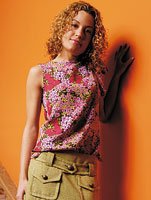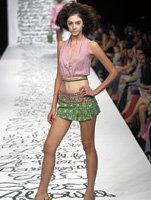Petro Zillia: Designing Local Color
Nony Tochterman is as colorful as the designs that make up her Petro Zillia ready-to-wear collection.
The 37-year-old designer has been known to flaunt a head of psychedelically wild orange hair. But these days, her curls have turned light pink—her hair color changing like the fashions that have been winning her accolades across the country.
Tochterman is currently contemplating her next hair color as she and her assistant designer, Louiza Babouryan, tweak the silhouettes in the Fall/Holiday 2004 collection, which will debut at the Fashion Coterie in New York before appearing on the runway at the end of March at Mercedes-Benz Fashion Week at Smashbox Studios in Culver City, Calif.
Last season, the designer was a lastminute addition to Mercedes-Benz Shows L.A. (now called Mercedes-Benz Fashion Week at Smashbox Studios) at the Downtown Standard Hotel in Los Angeles, which didn’t give her much time to prepare. This time, Tochterman, who is organized almost to a fault, does not want to put a crimp on her creative energies, which have been serving her well.
At Los Angeles Fashion Week last fall, Tochterman put her own spin on feminine dresses and sportswear for Spring ’04 with geometric prints on 60s-inspired minidresses and tailored shorts, a recurring rainbow theme on breezy skirts and colorblocked sweaters, and an artfully-shaped crotchet mini dress.
“She has amazing spirit, energy and vitality to her clothes. There is great color and exuberance,” said Fern Mallis, executive director of 7th on Sixth, the organizer of Mercedes-Benz Fashion Week at Smashbox Studios. “I think her influence is starting to be felt in many places.”
The past few years have been momentous for the creative designer and mother of two, who works out of an artfully decorated— and very colorful—design studio in Van Nuys, Calif.
She has basically achieved what she set out to do a long time ago: develop an internationally recognized ready-to-wear collection. Currently, the line is carried by specialty boutiques and better department stores worldwide, including Saks Fifth Avenue, Blush in New York, Shaya in Los Angeles, Mac in San Francisco, Victoire in Paris, Isetan in Tokyo, Selfridges in London and Galassia in Rome.
Tochterman and her husband, Yosi Drori, founded the company more than six years ago as an accessories, scarves and handbags business and steadily grew the line to include women’s clothing.
The heart of the clothing company is found in a nondescript, modest-sized building that serves as a repository for Petro Zillia’s bright, colorful gowns and sportswear collection. Part design center and part library, the 5,000- square-foot, two-story loft building houses offices, a design studio, a production room with four sewing machines and one knitting loom. The upper level—filled with pastel-colored fabric rolls, yarn and plastic containers holding fancy trimmings and sparkly appliqueacute;s— is like an old-fashioned candy store but for a fashion designer.
“I organize it so I can see inside the boxes,” Tochterman said. “I love patchwork—it’s about the assortment you put together.”
After the samples are made in the studios, they are shipped to local contractors for reproduction.
Ever-changing look
Tochterman’s signature technique is to coordinate contrasting fabric pieces in each silhouette, either as patchwork, lining or trim.
“I like to reinvent myself every season,” said Tochterman, who is often dressed in a kaleidoscope of colors. This season’s favorites: lime green and cotton-candy pink. “What I am most consistent with is color, texture and patchwork; it’s got to be light, fun and happy.”
Her forthcoming collection is a slight departure from the brightly colored whimsical prints—flowers and rainbows—featured in her Spring 2004 line.
The new collection has a Cotton Club theme, Tochterman said. It is tailored and has a darker color palette than that of previous seasons—although the collection is lined with bright silk fabrications.
For Fall/Holiday 2004, silhouettes include suits, jackets, pants, skirts, coats and dresses. Button-down shirts are layered with short, wide neckties.
The new line draws on tweeds, herringbone and plaid prints. A belted, striped wool coat with floral lining, a short-sleeved sweater with silk sleeve extensions and an A-line skirt with pleats are just some of the pieces in the collection. Wholesale price points range from $30 for a novelty T-shirt to $448 for a handcrocheted mohair sweater poncho. Delivery dates begin Sept. 30.
“Petro Zillia is for the Holly Golightly woman of the new millennium,” professed Ben Ospital, partner at San Francisco’s Modern Appealing Clothing, a men’s and women’s contemporary boutique where the line has developed a strong following. “Nony designs for the sophisticated young woman who is claiming her own role in the world.”
Tochterman also designs one-of-a-kind evening gowns, which retail from $1,500 to $5,000. Her silk chiffon gowns with leather crochet and ribbon trim accents are popular among stylists and high-end boutique buyers, but the line’s distribution is limited. Last year, Tochterman made only 15 gowns.
Petro Zillia’s offbeat, nontraditional silhouettes are also making inroads in Hollywood. Stylists from television shows “Will & Grace” and “The O.C.” have become fullblown fans.
“Nony plays with colors in a good way,” said Alexandra Welker, costume designer for “The O.C.” “In her collection, the silhouettes and fabrications don’t all look like they’re part of the same collection. In other words, each piece works together with other pieces but maintains its own individuality.”
The ABCs of fashion
Tochterman, who could knit at an early age, learned about retail and the creative side of the business from her mother, who designed clothing and operated an apparel boutique in Israel, where the family lived until Tochterman was a teenager.
Tochterman later moved to New York, where she worked as a store manager at a better apparel boutique and started a custom jewelry company with Drori called Nony New York, which helped set off the button-cover trend of the late ’80s.
Tochterman and Drori arrived in Los Angeles in 1997 and launched the accessories and apparel collection. They called the line Petro Zillia, which is Hebrew for “parsley,” after searching for a name that would evoke a glamourous European designer. The two arrived in Los Angeles at a time when many local designers had begun vying for an official West Coast fashion week. “We knew it would be a good opportunity for us to get our name out there and relay that message at fashion shows in the spirit of who we are,” Tochterman said.
While Tochterman has succeeded in reaching out to the fashion community, she maintains a modest point of view.
“I believe fashion is a form of artistic expression and one should express herself through the clothes she chooses to wear,” said the designer. “I try to create clothes that would inspire a happy and positive mood and frame of mind. I don’t really take myself that seriously. I have fun in what I do. I enjoy the people I work with—because it’s only fashion.”
























